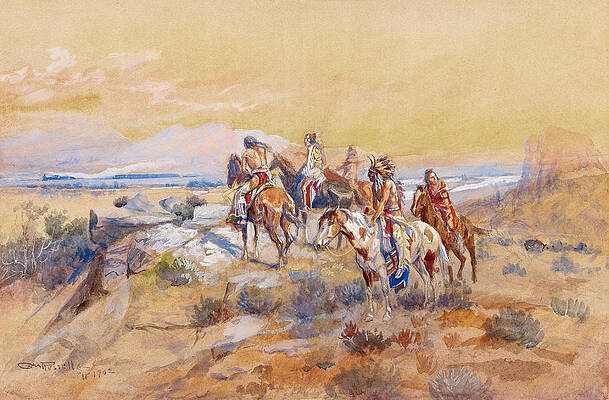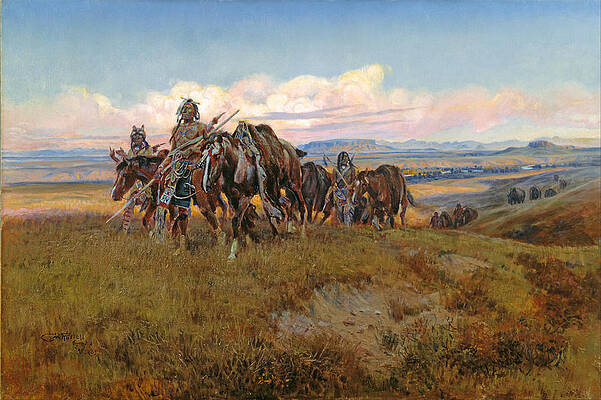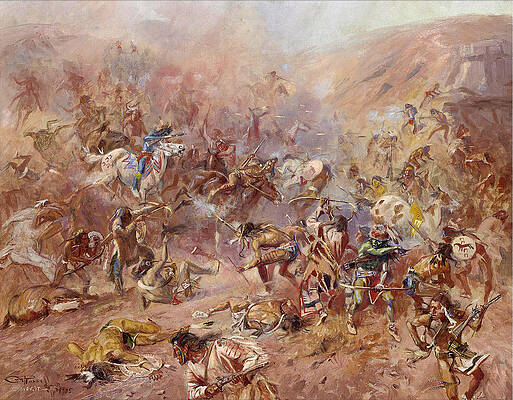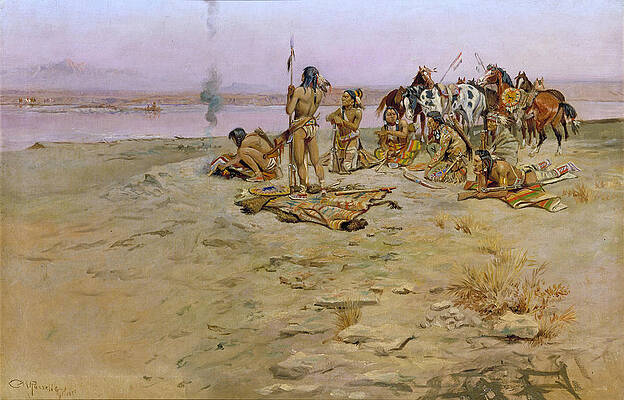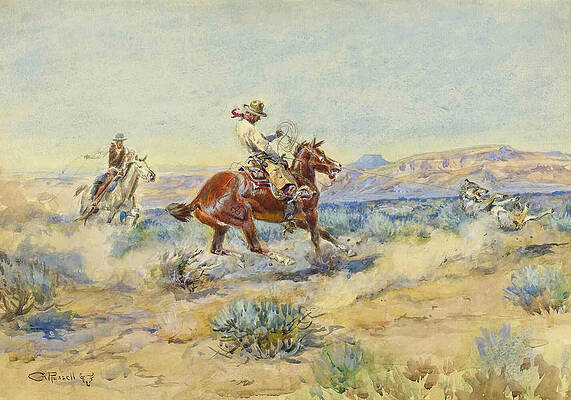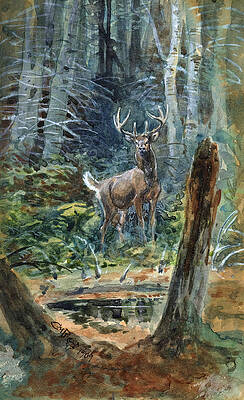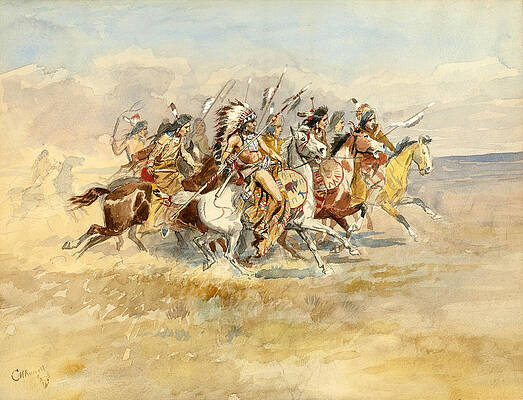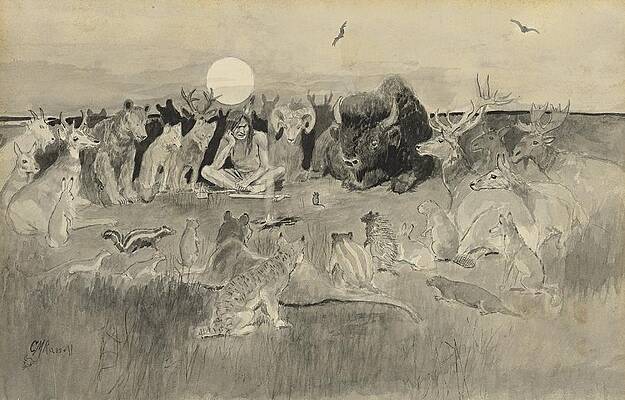Charles Marion Russell
Paintings, Drawings
In Without Knocking
Watching the Iron Horse
Bucking Bronc
Buffalo Hunting
The Tenderfoot
In the Enemys Country
Smoke of a 45
Indian Preparing a Pipe
Blackfoot Indian. A Crow Scout
The Battle at Belly River
The Signal Fire
Buffalo Hunt 2
The Death Song of Lone Wolf
A Pitcher
Buffalo Hunt
War Party
Deer in the Dell
Blackfeet War Party
The Great Game for the Rulership of the World
Indians Stalking Elk
Cowboys on the Plains
An Old Time Hunting Party
Indian Party
Indians Traveling on Travois
Blackfoot Indian
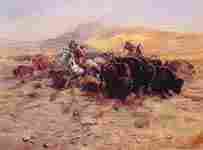
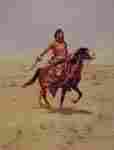
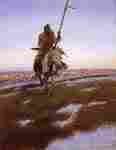




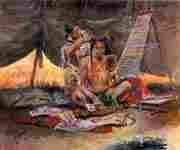

Blackfeet Burning Crow Buffalo Range


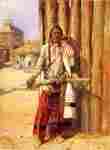


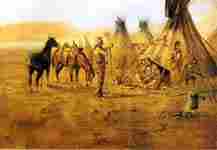

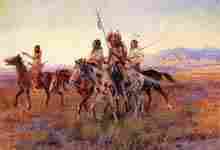
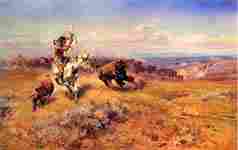
Horse of the Hunter aka Fresh Meat
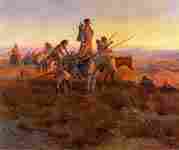
In the Wake of the Buffalo Hunters

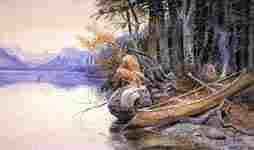
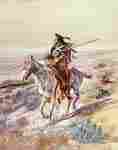
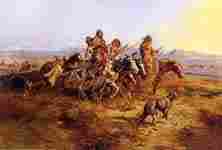

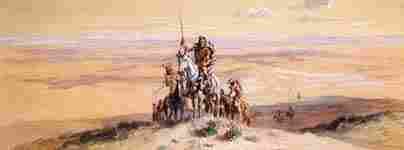
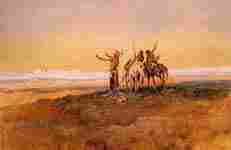






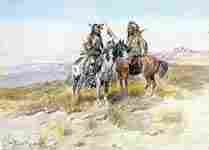
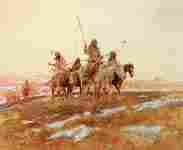
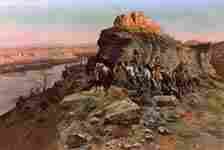
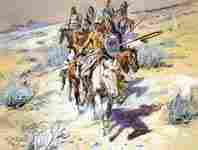













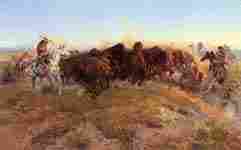
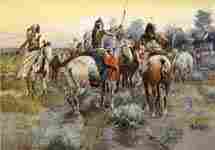


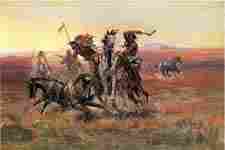

When Law Dulls the Edge of Chance


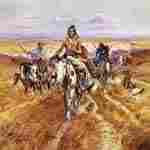


Charles Marion Russell (March 19, 1864 – October 24, 1926),[1][2] also known as C. M. Russell, Charlie Russell, and "Kid" Russell, was an American artist of the Old American West. Russell created more than 2,000 paintings of cowboys, Indians, and landscapes set in the Western United States and in Alberta, Canada, in addition to bronze sculptures. Known as 'the cowboy artist', Russell was also a storyteller and author. The C. M. Russell Museum Complex located in Great Falls, Montana houses more than 2,000 Russell artworks, personal objects, and artifacts. Russell's mural titled Lewis and Clark Meeting the Flathead Indians hangs in the state capitol building in Helena, Montana. Russell's 1918 painting Piegans sold for $5.6 million at a 2005 auction.

Charles Marion Russell, US Postage stamps
Childhood
Art was always a part of Russell's life. Growing up in Missouri, he drew sketches and made clay figures of animals. Russell had an intense interest in the wild west and would spend hours reading about it. Russell would watch explorers and fur traders who frequently came through Missouri. Russell learned to ride horses at Hazel Dell Farm near Jerseyville, Illinois on a famous Civil War horse called "Great Britain". Russell's instructor was Col. William H. Fulkerson who had married into the Russell family. At the age of sixteen, Russell left school and went to Montana to work on a sheep ranch.[5]
Adulthood
Russell came to Montana in 1880 at the age of 16. After an unsuccessful stint working on a sheep ranch, he found work with a hunter and trapper turned rancher named Jake Hoover, who owned a ranch in the Judith Basin, and from whom Russell learned much about the ways of the west. The two men remained lifelong friends.[6] After a brief visit to his family in 1882, he returned to Montana, where he remained for the rest of his life. He worked as a cowboy for a number of outfits, and documented the harsh winter of 1886-1887 in a number of watercolors.[6] Russell was working on the O-H Ranch in the Judith Basin of Central Montana at the time, when the ranch foreman received a letter from the owner, asking how the cattle herd had weathered the winter. Instead of a letter, the ranch foreman sent a postcard-sized watercolor Russell had painted of gaunt steer being watched by wolves under a gray winter sky. The ranch owner showed the postcard to friends and business acquaintances and eventually displayed it in a shop window in Helena, Montana. After this, work began to come steadily to the artist. Russell's caption on the sketch, "Waiting for a Chinook", became the title of the drawing, and Russell later created a more detailed version which is one of his best-known works.
Beginning in 1888, Russell spent a period living with the Blood Indians, a branch of the Blackfeet nation.[7] It is believed that much of his intimate knowledge of Native American culture came from this period.[6] Upon returning to white culture in 1889, he found the Judith Basin filling up with settlers, so he worked in more open places for a couple of years before settling in the area of Great Falls, Montana, in 1892, in an attempt to make a living as a full-time artist.[6]
In 1896, Russell married his wife Nancy. He was 32 and she was 18.[6] In 1897, they moved from the small community of Cascade, Montana to the bustling county seat of Great Falls, where Russell spent the majority of his life from that point on. There, Russell continued with his art, becoming a local celebrity and gaining the acclaim of critics worldwide. As Russell was not skilled in marketing his work, Nancy is generally given credit in making Russell an internationally known artist. She set up many shows for Russell throughout the United States and in London, creating many followers of Russell.
In 1913, Russell painted Wild Horse Hunters which depicts riders capturing wild horses, each band of which is dominated by a stallion. He used as much color as an artist could on his mountain landscapes.[8] Russell the artist arrived on the cultural scene at a time when the "wild west" was being chronicled and sold back to the public in many forms, ranging from the dime novel to the wild west show and soon evolved into motion picture shorts and features of the silent era, the westerns that have become a movie staple. Russell was fond of these popular art forms and made many friends among the well-off collectors of his works, including actors and film makers such as William S. Hart, Harry Carey, Will Rogers and Douglas Fairbanks. Russell also kept up with other artists of his ilk, including fellow Old West painter Edgar Samuel Paxson, painter Edward "Ed" Borein and Will Crawford the illustrator.
On the day of Russell's funeral in 1926, all the children in Great Falls were released from school to watch the funeral procession. Russell's coffin was displayed in a glass sided coach, pulled by four black horses.[9]
A collection of short stories called Trails Plowed Under[10] was published a year after his death. In 1929 Nancy Russell published a collection of Charlie's letters titled Good Medicine.
Tributes
Russell's log cabin studio, in Great Falls, Montana. Preserved and now part of the C.M. Russell Museum complex
Smoke of a .45
"Meat for Wild Men," bronze sculpture, depicting a buffalo hunt
The Buffalo Hunt 1899, Amon Carter Museum, Fort Worth
Many Russell paintings and bronze works are displayed in the Amon Carter Museum in Fort Worth, Texas, as well as the R.W. Norton Art Gallery in Shreveport, Louisiana along with the other most prominent western artist Frederic Remington. Additional major collections of Russell art can be found at the Montana Historical Society museum in Helena, Montana, the C.M. Russell Museum in Great Falls, Montana and the Rockwell Museum in Corning, New York.
Along with Jeannette Rankin, the first female member of the United States Congress, Russell represents Montana in the National Statuary Hall Collection in the United States Capitol.
In 1960, Charles M. Russell Elementary School was built in Missoula, Montana. In 1965, a high school was built on the north side of the Missouri River in Great Falls, Montana and named Charles M. Russell High School, in honor of Russell. Ian Tyson's 1987 album, Cowboyography, includes a song titled "The Gift" telling the story of Russell. Michael Nesmith, of Monkees fame, recorded a song titled "Laugh Kills Lonesome" which was inspired by, and describes the contents of, a well-known Russell painting of the same name. Native Blackfeet folk singer Jack Gladstone wrote a song dedicated to Russell titled "When the Land Belonged to God." The song describes Russell's painting of the same name.
In 1991, Russell was inducted into the St. Louis Walk of Fame.[11] Some of Russell's paintings were shown during the credits of the ABC television series How the West Was Won, starring James Arness.
Russell was inducted into the inaugural class of the Montana Outdoor Hall of Fame in 2014.[12]
The Charles M. Russell National Wildlife Refuge is named for Russell, a World War II Liberty Ship, SS Charles M. Russell, was named in his honor and launched in 1943 in Portland, Oregon.
Auction success
Russell's Piegans sold in 2005 for $5.6 million, more than double the highest price his work had sold for a few years earlier.[13] At auction in 2008, Russell's oil painting The Hold Up (20 Miles to Deadwood) sold for $5.2 million, and his bronze sculpture Buffalo Hunt (which depicted two Native Americans attacking a running bison) sold for $4.1 million.[13] In July 2009, Russell's 1907 watercolor and gouache The Truce went for $2.03 million to an anonymous phone bidder.[14] Russell's 1911 18 inches (460 mm) by 13 inches (330 mm) bronze sculpture, Bronc Twister, auctioned in 2008 for $805,000—far above the $300,000 pre-auction estimate.[15]
In July 2011, the price of Russell's work soared again. His 1892 oil painting Water for Camp (depicting Native American women dipping pots into a stream) and his 1924 watercolor A Dangerous Sport (in which two cowboys lasso a mountain lion) sold for nearly $1.5 million each.[13]
A collection of 30 pieces of Russell's art were sold for several million dollars at the Coeur d’Alene Art Auction (held in Reno, Nevada) in July 2014, setting new records for many pieces. Russell's Trail of the Iron Horse watercolor (depicting a group of horseback Native Americans contemplating railroad track) sold for $1.9 million, while Dakota Chief (which depicts a young Lakota chieftain on horseback) was auctioned for $1.1 million (almost double the last price it commanded). Even small pencil sketches sold for $25,000.[16]
Notable works
See also: Paintings by Charles Marion Russell
Russell's works comprised a wide variety of topics, including major historical events and everyday life in the west. His work was noted for the frequency with which he portrayed well-known events from the point of view of Native American people instead of the non-Native viewpoint. He was noted for a keen eye on the social undercurrents of society and the meticulous authenticity with which he portrayed the clothing and equipment of both cowboys and Native people.
His portrayal of women has drawn critiques and assessment from historians studying women in the west. The contrasting levels of sensuality in his depictions of white and native women is noted in his artistic transference of sexuality from white to Native women, so as to conform to the moral standards and perceptions of women in his time. Most of Russell's portrayals of white women are shown as "pure" and non-sexual, other than those paintings specifically depicting prostitutes. In contrast, his series of five "Keeoma" paintings and related images show a sensual native woman, with accompanying legends that Keeoma was a real person that Russell had loved. However, photographs show that the body model for these images was actually Russell's wife, Nancy, who in doing so, critics note, was able to express her sexuality in a way generally not allowed "decent" white women of the time.[17]
Cowboy life
See also
Portal icon Biography portal
Earl W. Bascom, cowboy artist/sculptor influenced by and related to Charlie Russell
Harold Dow Bugbee, Western artist influenced by Russell
Arthur Roy Mitchell, Colorado artist
Dan Muller, cowboy artist influenced by C M Russell
J. K. Ralston, western artist
Frederic Remington, western artist
Notes
Dates and locations taken from Charles M. Russell, pg.1 & 318
Opitz, Editor, Glenn B. (1987). Mantle Fielding's Dictionary of american Painters, Sculptors & Engravers. Poughkeepsie, NY: Apollo Book. p. 1047. ISBN 0-938290-04-5.
"Retrieved 22-07-2009". Biographi.ca. Retrieved 2012-03-06.
"2005 auction results". Coeur d'Alene Art Auction. Retrieved July 26, 2008.
Tribune Staff. "125 Montana Newsmakers: Charles Marion Russell". Great Falls Tribune. Retrieved August 28, 2011.
Paladin, Vivian A. "Facts and Reflections About Charles M. Russell". Art Montana. Retrieved November 6, 2011.
Osmundson, Linda L. How the West Was Drawn: Cowboy Charlie's Art. Books.google.com. 2011-02-15. Retrieved 2012-05-05.
Russell exhibit, Amon Carter Museum, Fort Worth, Texas
Taliaferro, John Charles M. Russell: The Life and Legend of America's Cowboy Artist University of Oklahoma Press, 2003 p. 264 ISBN 978-0-8061-3495-6
"Trails Plowed Under". Gutenberg.net.au. Retrieved 2012-03-06.
St. Louis Walk of Fame. "St. Louis Walk of Fame Inductees". stlouiswalkoffame.org. Retrieved 25 April 2013.
http://missoulian.com/lifestyles/recreation/montana-outdoor-hall-of-fame-inducts-inaugural-class/article_ca3d81a3-c77c-5501-8a30-9c114bd4b34e.html
Griffith, Martin. "Bierstadt, Russell Paintings Fetch Millions at Reno Auction." Great Falls Tribune. July 26, 2011.
"In Brief: Couer D'Alene."Art+Auction, October 2009.
"Russell Bronze 'Bronc Twister' Top Hand At Richard Opfer's." Antiques and Arts Online. September 23, 2008. Accessed 2010-05-19.
Griffith, Martin (August 2, 2014). "Charles M. Russell's Artwork Sells for Millions at Reno Auction". The Washington Post. Retrieved August 3, 2014.
Armitage, Susan Hodge. "The Women's West". Books.google.com. Retrieved 2012-05-05.
Further reading
Adams, Ramon F. and Home E. Britzman, Charles M. Russell: The Cowboy Artist – A Biography, Trail's End Publishing, Pasadena, California. 1948.
Gale, Robert L., "Charles Marion Russell" Western Writers Series, Boise State University. Boise, Idaho. 1979. – available via the Western Writers Series Digital Editions
Hoeber, Arthur (July 1911). "The Painter Of The West That Has Passed: The Work Of Charles M. Russell". The World's Work: A History of Our Time XXII: 14625–14635. Retrieved 2009-07-10.
Russell, Charles M. Good Medicine: Memories of the Real West Garden City Publishing Company, Garden City, NY, 1930. Includes introduction by Will Rogers and biographical note and dedication by Nancy C. Russell.
Stauffer, Joan, Behind Every Man : The Story of Nancy Cooper Russell, University of Oklahoma Press, Norman, Oklahoma. 2008.
----
Fine Art Prints | Greeting Cards | Phone Cases | Lifestyle | Face Masks | Men's , Women' Apparel | Home Decor | jigsaw puzzles | Notebooks | Tapestries | ...
----
Artist
A - B - C - D - E - F - G - H - I - J - K - L - M -
N - O - P - Q - R - S - T - U - V - W - X - Y - Z
Retrieved from "http://en.wikipedia.org/"
All text is available under the terms of the GNU Free Documentation License




